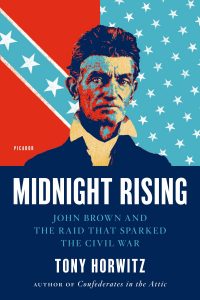Book Review: Midnight Rising
…follow him they did, swearing allegiance to his revolutionary government and marching into Virginia to found a new order. Within two years, entire armies would cross the Potomac, and this obscured the magnitude of what happened in 1859. The street violence at Harpers Ferry came to seem almost quaint by comparison with the industrial-scale slaughter at Antietam and Gettysburg. In time, the uprising became known as John Brown’s Raid, a minor-sounding affair, like one man’s act of banditry.
But no one saw it that way at the time. A month after the attack, under the headline “HOW WOULD IT FIGURE IN HISTORY,” a Baltimore newspaper listed the many labels given to the recent violence in Virginia. The most common were “Insurrection,” “Rebellion,” “Uprising,” and “Invasion.” Further down the list appeared “War,” “Treason,” and “Crusade.” There were twenty-six terms in all. “Raid” was no among them….
 Tony Horwitz is remembered for his lively writing style and new ways of looking at subjects. In his 2011 history book entitled Midnight Rising: John Brown and The Raid that Sparked the Civil War, he uses words to bring the historical event, characters, and larger national setting to life. The book is concise, fast-paced, and packed with informative historical facts and solid interpretation points. Readers take away things to consider or reconsider throughout the text, similar to the excerpt above.
Tony Horwitz is remembered for his lively writing style and new ways of looking at subjects. In his 2011 history book entitled Midnight Rising: John Brown and The Raid that Sparked the Civil War, he uses words to bring the historical event, characters, and larger national setting to life. The book is concise, fast-paced, and packed with informative historical facts and solid interpretation points. Readers take away things to consider or reconsider throughout the text, similar to the excerpt above.
John Brown’s life, commitment to the abolition cause, religious beliefs, and tendency toward violence to accomplish an end are detailed in the first third of the book while the last two sections deal with the actual raid followed by the trial and the memory. Brown is presented honestly – not as a hero, not as a martyr, not as a lunatic – rather as a complicated man with set of strict and conflicting beliefs.
Reading this book can answer many of the factual questions about John Brown, but in some ways the text also respects all that will probably never be exactly known. Even as the reader discovers the historical answers, he/she will be faced with the looming question marks offered by John Brown’s words, actions, and intended legacy.
In addition to the closer look at this radical abolitionist and his Harpers Ferry attempt, the book delves into Brown’s time in Kansas, his family life, his children’s ties to abolitionism, his wealthy financiers in the elite North, and the lives of the other men who joined him on the raid. All these details are interwoven with clear, concise recaps of the national and sectional settings within the United States and how society generally functioned and responded to the abolition movement and John Brown’s violence.
If you’re looking for an exciting re-telling and fast-paced history on the 1859 events in Harpers Ferry with a solid background on the raiders, John Brown, and his beliefs, find (or reread) Tony Horwitz’s book. If you have read it, what points or facts really stood out to you?
Note: I read this book for the first time in preparation for this blog series, but I read it in the car (not while I was doing the driving, of course) on a cross-country trek. I happened to be reading the part about Brown’s violence in Kansas while actually traveling through that state. A day or two later, I realized that we had crossed into West Virginia, and I was reading the section about Brown’s trial and execution which took place in the area now encompassed by the modern state of West Virginia. It hasn’t been often that I’ve had the opportunity to read about a historic event connected to Civil War history and actually be in the same state where it occurred!

I hope anyone with an interest in this time will read this book.
Tony Horwitz’s ability to make this time frame understandable is remarkable!
Confederate in the Attic is just as great.
Thank you Sarah Kay Bierle for your time ss well.